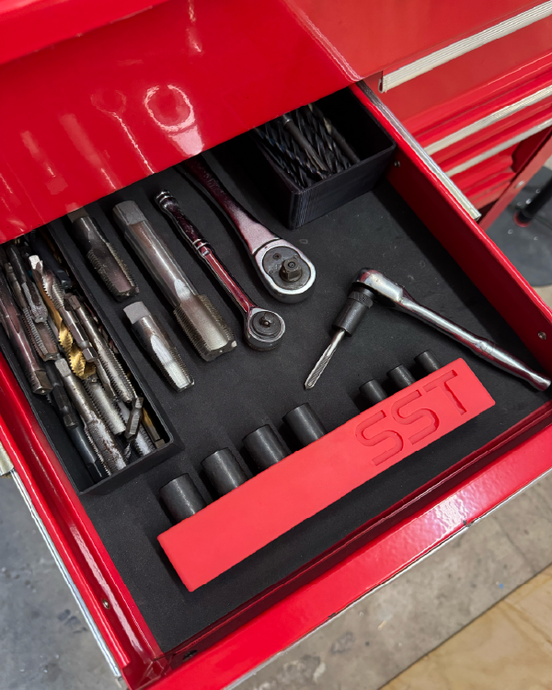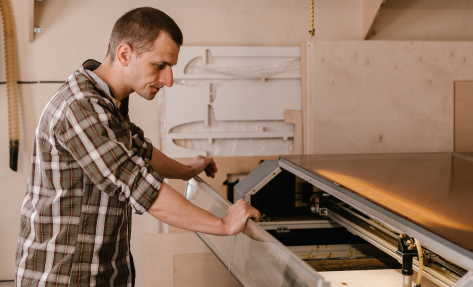SST Shop Talk
Toolboxes: Configurations, Materials, and Tactical Organization

For serious makers, engineers, or shop techs, a toolbox isn't just storage—it's a mobile command center. Whether you're machining precision parts, wiring up a prototype, tuning suspension, or assembling a 3D printer from scratch, your toolbox must support fast access, logical layout, and long-term durability.
This guide breaks down toolbox types, build quality considerations, and advanced organization methods geared toward professionals and high-skill hobbyists.
Toolbox Types for Experienced Makers
Choosing the right toolbox begins with understanding how you move, store, and access your tools. These are the primary categories worth considering:
1. Modular Rolling Systems
- Best For: Fabricators, mobile technicians, field engineers
- Brands to Know: Milwaukee Packout, DeWalt ToughSystem, RIDGID Pro
-
Strengths:
- Modular stackable units (drawers, bins, open crates)
- Locking mechanisms for transit
- IP-rated weather seals for on-site use
- Use Case: Transporting components, power tools, consumables (like wire or fasteners), and precision tools to job sites or between workspaces.
2. Tool Chests and Cabinets
- Best For: Stationary workspaces, machinists, and automotive techs
- Common Sizes: 26", 36", 52", and larger double-bay setups
-
Pro Features:
- Ball-bearing drawer slides with 100–200 lb weight ratings
- Full-width drawer pulls and locking mechanisms
- EVA foam or Kaizen foam organization
- Use Case: Organizing full wrench sets, micrometers, pullers, socket rails, pneumatic tools, and dedicated drawer setups for electrical, fabrication, or measurement gear.
3. Portable Hand-Carry Boxes
- Best For: Field service calls, electrical work, and light-duty mobile kits
-
Preferred Builds:
- Steel (e.g., Kennedy, Proto) for durability
- ABS or polypropylene for lightweight transport
- Removable trays for hand tools or test equipment
- Use Case: Custom loadouts for small jobs—such as soldering tools, fastener assortments, or precision screwdrivers for electronics.
4. Drawer Inserts and Tool Wall Integration
- Best For: Custom shop builds or dedicated fab benches
- Examples: French-cleat tool walls, CNC-routed foam drawer liners, shadow boards
- Pro Tip: Design tool zones based on task flow—e.g., layout → cut → assemble → finish.
Construction Materials: What Actually Matters
Experienced users know that cheap plastic won't survive a decade of hard use. Here's what to look for in toolbox construction:
| Material | Pros | Cons |
|---|---|---|
| Cold-Rolled Steel | High strength, rigidity, repairable (weldable) | Heavy, can rust if finish wears |
| Aluminum | Lightweight, corrosion-resistant | Can dent under impact |
| Reinforced Polypropylene | Durable, weather-resistant, modular design | Less rigid under extreme load |
| Stainless Steel | Corrosion-proof, great for clean environments (labs, food-grade shops) | Expensive, heavy |
Look for: Powder-coated finishes, gas struts on top-lid boxes, welded corners, and riveted hardware over plastic latches.
Tactical Toolbox Organization for Makers
You know what it's like to dig for a T25 Torx while a project's cooling down. Efficient organization reduces wasted motion and project downtime.
1. Kaizen Foam + CNC/Manual Cut Inserts
- Route or hand-cut tool profiles into layered foam
- Visual inventory at a glance (missing tool shadows)
- Custom-fitted to tool chests or drawer inserts
2. Tool Zoning
Organize drawers or boxes by function, not just type:
- Layout Drawer: Calipers, rulers, scribes, machinist squares
- Fastening Drawer: Impact sockets, torque wrenches, thread locker
- Electrical: Multimeter, heat shrink, strippers, ferrule crimpers
- Consumables: Zip ties, o-rings, abrasives, gasket material
3. Label Everything
Use thermal or vinyl labels with size ranges (e.g., "Socket Set: 7mm–19mm, Deep/6pt") for fast tool retrieval.
4. Standardize Rails & Trays
- Socket rails: Magnetic or locking types that prevent spillage
- Bit trays: Foam holders for hex, Torx, security, and Phillips bits
- Wrench organizers: Angle rack trays or folding pouches by size
Advanced Toolbox Tips from the Field
- Match drawer load to slide rating: Overloading drawers with heavy sockets or metal tools will wear them out fast unless rated ≥100 lbs.
- Use desiccants or tool-safe rust inhibitors in sealed boxes, especially in humid environments.
- QR code inventory: Link a QR label to a spreadsheet or inventory app for tracking specialty tools or calibration due dates.
- Secondary "Go Kit": Maintain a separate bag or pouch for rapid deployment, e.g., field electronics, brake bleeding tools, or diagnostic gear. For field work involving mixed fasteners, consider adding bolt identification tools to streamline hardware sorting and prevent project delays.
Final Thoughts
The best toolbox isn't just the one that holds your gear—it's the one that complements your workflow, protects your investment, and keeps your projects moving forward. Whether you're building drones, tuning suspensions, machining precision parts, or wiring control panels, your toolbox should serve as an extension of your process—not a limitation.
Design your toolbox the way you build your projects: with purpose, precision, and performance in mind.
The Programmer
The first person is the CNC programmer. He is like the "playmaker". He will create the programs that the CNC machines are intended to execute. Since the programs are in the form of CNC codes fabricated like sentences, he should have mastered these codes because they work like a different language. The regular CNC machine can use up to 50 codes, so that's like learning 50 new words for the newbie.
Also, the programmer should have at least and engineering or machining degree. Remember that the CNC machine will only execute WHAT IT IS PROGRAMMED TO DO. If the program is wrong, the whole operation goes down the drain with it. Moreover he should also be flexible and have a fast turn-around because a CNC machine is often used to machine a huge selection of different work-pieces.

The Technician
The third person that will need is the CNC technician. Although this may still be the programmer, it is more convenient to always have a technical expert on-call because in the long run, you may have more than one CNC machine and you may need to prioritize over the other in case both gets crippled at the same time. Just like the programmer, the technician should also be flexible and articulate. CNC offers a lot of complexity when it is running right, how much more if it is behaving badly?
So, if you are having job openings for positions that need to be handling a CNC machine, ask the applicants first to do a demo for you and make sure that during the demo, they know what they're doing. An exam may also do wonders too. If they have no experience with any kind of CNC machine, it is advisable that you encourage them to take short courses on CNC.
Eighty-hour courses are available online and hey, it is better than nothing. Experts even encourage employers to hire CNC machinists who have finished AND PASSED the National Occupational Competency Testing Institute (NOCTI) assessment just so they could be sure that their CNC machines will go to good hands. After all, a CNC machine is still an asset.

The Operator
The second person that you need is the CNC operator. He will simply recheck the programs loaded to the machine and push the right buttons to get the work done. However, thinking that a CNC operator can have little or NO SKILL AT ALL is wrong. A CNC machine operator must have at least basic machining skills and he should have undergone some form of training to run a CNC machine.
These machines can produce very intricate motions, making it possible to make shapes that cannot be created on conventional machine tools. So, the operator should foresee this complexity and know how to cruise with it. The skills that an operator must have though, are lesser compared to the operators of conventional machine tools.



